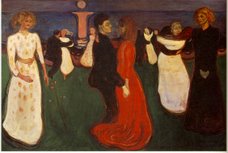"I am travelling at the speed of time, along the Massachusetts Turnpike.
For months, for years, for most of my life, I have been hovering like an
insect against the screens of an existence which inhabited Amherst,
Massachusetts, between 1831 and 1884."
Thus starts the essay on Emily Dickinson written by Adrienne Rich. She, as I have done myself, sees Dickinson as someone who chose living withdrawn from the rest of the world. In order to write, or simply to have a freedom most women of her time did not have.
In a way, Jane Austen did something of the same, refusing a proposal (by a man she couldn't really stand, though), and Søren Kierkegaard (happy 200 years!) who broke his engagement to his fiancée called Regine, causing quite the scandal in 19th century Copenhagen. In order to work and write, he saw this as necessary, although painful. In our day we want it all.
(I am of course acquainted with Lyndall Gordon's theory in the book Lives like loaded guns where an argument is made for how Emily Dickinson retreated into her house due to epilepsy. Which is also a likely possibility. But thinking that she chose this fate in order to be free and able to write is quite plausible, and also a bit more poetic.)
I remember thinking almost exactly what Rich expresses here: "I have a notion that genius knows itself; that Dickinson chose her seclusion, knowing she was exceptional and knowing what she needed. It was, moreover, no hermetic retreat, but a seclusion which included a wide range of people, of reading and correspondence." Emily knew she was special. And how could she be able to write in a traditional family life back in the 1800s? She saw the possibility of staying in her house filled with books, flowers and baking and filled her life with writing -- poetry, letters and everyday notes to family members, including sister-in-law Sue. This was obviously an important way for her to keep in contact with people. Through the written word she was letting people know who she was, how she was thinking and expressing herself, and also of course keeping up human relationships of sorts. My friends are my estate" she wrote in a letter, "forgive me then the avarice to hoard them". Rhythm and elegance of expression seem to run through her every wording.
The community was close, and Emily Dickinson was an active part of it in her way. That she was seen as different is no secret, but she was valued in her differentness. There were even some (rather daft, in my opinion) girls who tried to mimick her reclusiveness. Like her specialness lay in her staying indoors. She was known as a writer in her own day, though she didn't publish more than seven poems during her lifetime, not always in her own name, and always edited away from her strongly individual style. Possibly the fact that she was a woman clouded the minds of her early editors (i.e. Mabel L. Todd) and compelled them to "beautify" Dickinson's poetry, in order to please the eyes of the readers of her time. Or it was simply Emily Dickinson's stark talent and expression and her difference from any other thinker-writer that initially made them force her writing into a mould they could accept as poetry.
I'll conclude with Adrienne Rich's words: "Given her vocation, she was neither eccentric nor quaint; she was determined to survive, to use her powers, to practice necessary economies."
A bold choice. Gaining us, her readers.









